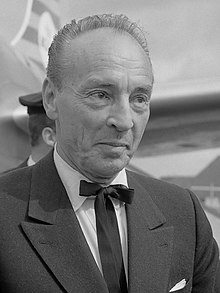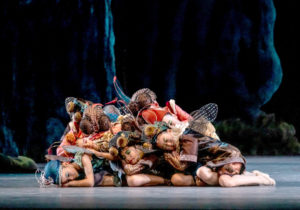The San Francisco Ballet presented a perfect dream of this ballet, March 12-23 at the SF War Memorial Opera House. It was choreographed by George Balanchine in the US, in 1962. It was his second full-length story ballet, first was his Nutcracker, but the Dream was the first he choreographed in America. The dancing by the whole company could not have been better. The costumes and sets were beautiful. The designs are original with trees lifting up to change scenes and to return to the forest. Huge and lovely pansy flowers on the scrims also went up and down. The design had to change from fairy world to human world, so changing the scale of the set was necessary. The delicate pansy faces were enormous next to the dancers who were supposed to be very small. Every detail added to the life of the Dream.
The Music In addition to the choreography, the brilliant dancers, the costumes and sets, remember the music. Felix Mendelssohn read Shakespeare’s play and was so inspired by it that he wrote the sublime concert overture when he was seventeen. King Frederick William IV of Prussia commissioned Mendelssohn to add to that overture. Ludwig Tieck was producing the play; it needed more music. Clearly, it had to be more from Mendelssohn.
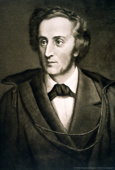 Felix Mendelssohn, Composer (1809-1847)
Felix Mendelssohn, Composer (1809-1847)
He composed songs and the Wedding March which naturally introduces the triple wedding that opens Act II. Balanchine knew music. He spent time selecting more Mendelssohn in order to “weave the ballet together musically,” said Sandra Jennings, repetiteur of the Balanchine Trust, the person who knows the work so intimately that she can come to San Francisco and teach steps, timing, character, drama and humor.
Pandemic Interruption There is a timely back story about the Dream’s relationship with the SF Ballet. The company was to premiere their Dream on March 6, 2020. The performance began, then, in the middle, the Office of the Mayor announced the entire performing arts center had to close. The uninvited virus had moved in. SF Ballet brought the dancers back to the Opera House and filmed the Dream for the evacuated ticket holders. The version to be performed in 2020 had come from the Pacific Northwest Ballet, a fine company known for Balanchine dancers and choreography. The sets were designed for the plants and animals on the Pacific Coast.
“Extravagant things” The sets and costumes we saw this year were commissioned by the Paris Opera Ballet, in 2017. Every costume was gorgeous. Each costume was different from every other one. Even the Bugs, danced so well by young students of the SF Ballet School, had very special colors, designs, and antennae. Every courtier, butterfly, royalty of the human or of the fairy world was original. The sets and costumes were designed by Christian Lacroix who stated, “I love extravagant things. Tutu is one of them.” Were you hoping to find something sparkling with Swarovski crystals maybe to wear to an SF Ballet performance? Forget about it. Swarovski crystals by the million, hundreds of yards of lace by Sophie Hallette; it has all gone on to these costumes. (Please note: these photos, courtesy of the SFB, were taken in dress rehearsal and do not show all the casts.)
Bugs take a nap in the forest. The students of the SF Ballet School danced flawlessly.
Do you know the story? It may be impossible to narrate it briefly. The King of the Fairies, Oberon, and his Queen, Titania, have a quarrel. Titania has a darling young boy as her favorite Page. Oberon wants the Page on his side of the forest. Puck, an ingenious, flying, trouble-making elf, promises to do Oberon’s assignment. He will find the flower “pierced by Cupid’s arrow” which has the power to make anyone dusted with its pollen fall in love with the first animal, vegetable or mineral she or he sees. Puck succeeds in this mission. Meanwhile, Puck turns a rustic worker named Bottom into a Donkey, and he is the first person Titania sees.
While this happens in the fairy world, there are four humans wandering into the forest. Helena loves Demetrius, but Demetrius does not love Helena. Hermia loves Lysander and Lysander loves Hermia, but they lose each other in the forest. Oberon observes the course of true love running off the rails and tells Puck to use the flower’s power to make Demetrius love Helena. However, Puck makes Lysander love Helena instead. Now Hermia is at a loss. Puck redoes his magic and makes Demetrius fall in love with Helena. That works, except that now both men are after Helena and fight over her.
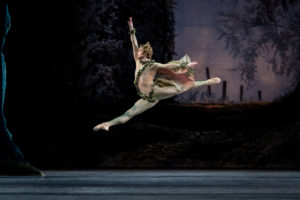
Cavan Conley as Puck. The performance on March 21 featured Alexis Francisco Valdes as Puck.. He was spectacular. On the 21st, Cavan Conley danced Oberon, also terrific.
Russian style leaps It interests me that Balanchine choreographed this ballet early in his life in America. Puck performs fabulous leaps. They turn in the air sometimes with both legs tucked up or kicking one or changing directions in mid-air. There is a great Russian tradition of male dancers who specialize in jumps and leaps as though they are able to climb and tumble or just stay still in space. A marvelous example of this was the late Valery Panov. There is a film of him dancing as a Jester which will make anyone watching gasp.
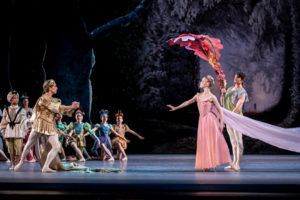
Bugs: S-Vallejo, Widjaja, Maldonado, Allaire, Paul, Yin, Denman, O’Leary-Herreras, Pickert, Whiteley, Trias
Titania’s Page: Ganaden, see him at the far left in a turban. Oberon and Titania have trouble negotiating.
Beats Another movement theme in Balanchine’s choreography are the difficult repeated beats. A beat: standing with legs crossed, one foot in front, jump up keeping legs straight in the air, change the front one to the back and then cross it again to the front, and land. Mr. B has everyone doing multiple beats at every possible chance. Kick a leg straight to the front, jump off it to kick it to the back but do not let that back kick happen without bringing the legs together for some gratuitous beats. The foot work is sparkling more than the million crystals. Although the human couples get mixed up, and the men are fighting, Puck lets them tire themselves out. They fall asleep. Puck arranges Helena beside Demetrius and Lysander sleeps near Hermia. These final spells will just have to stay.
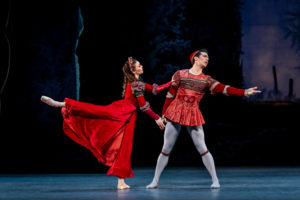
Elizabeth Mateer and Steven Morse as Helena and Demetrius. He is reaching for his new attraction: Hermia. On March 21, these roles were danced by Jasmine jimison and Daniel Deivison-Oliveira. The dancing was superb throughout the entire performance.
Oberon sees his beautiful Queen embracing Bottom. He cools his anger, allows Bottom to go back to being himself, and restores Bottom to his friends; this is Oberon’s way to restore Tatiana to himself.
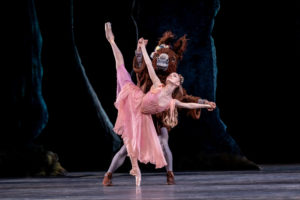
Sasha De Sola and Alexis Francisco Valdes dance as Titania and Bottom. She’s in love with a Donkey. The cast on March 21 was Nikisha Fogo, Titania, and Joshua Jack Price as Bottom.
Casts The company switched roles throughout the long run of this ballet. That is a challenging arrangement, but it worked. The dancers I saw were wonderful as though that one character and choreography was their one and only to perform. However, Nikisha Fogo danced Tatiana and also The Queen of the Amazons. On different nights, of course. For example, The Butterfly, a solo part, was performed beautifully on the 21st by Isabella Devivo.
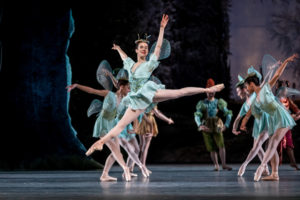
Julia Rowe in the picture above as the Solo Butterfly. On the 21st, Isabella Devivo was light as a butterfly and managed to fly as well. She has her own Corps de Butterflies.
The Royalty, Theseus, Duke of Athens and Hippolyta were pleased that the humans had made peace.
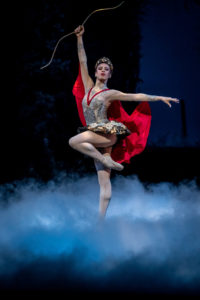
Nikisha Fogo danced the Amazon Queen. On March 21, Jennifer Stahl performed this role. She executed in perfect technique what I think was 20 fouette turns. I counted, but when I got to about 18 I was too impressed to keep counting.
They decided to have a glorious triple wedding with the two couples who had found happiness and with their Royal Selves. Act II brings the vast cast together in splendid white wedding costumes accompanied by the Wedding March. It is said that of the music for weddings, the Mendelssohn brings the best of luck. Act II brought opportunities for more truly great dancing. It started as an ordinary Thursday night, but everyone in the Opera House was smiling and happy and a little bit reluctantly dancing away.
Photos by Lindsay Thomas, courtesy of the San Francisco Ballet.
